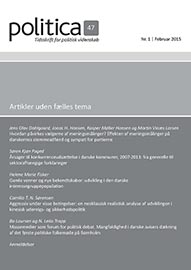Gamle venner og nye bekendtskaber: udvikling i den danske interessegruppepopulation
DOI:
https://doi.org/10.7146/politica.v47i1.131478Abstract
Interessegrupper kan bidrage til et velfungerende demokrati, idet de kan sikre diversitet i koret af stemmer i det politiske system. Men er der mere diversitet i den danske interessegruppepopulation i dag end tidligere? Fire forskellige samfundsudviklinger: nye politiske værdier, demografiske ændringer, ændrede korporative strukturer og velfærdsstatens ekspansion påvirker, hvordan den danske interessegruppepopulation har udviklet sig i forhold til sammensætningen af forskellige gruppetyper. Der er mere diversitet i den danske interessegruppepopulation i dag end i 1970’erne, hvor de økonomiske organisationer som arbejdstager- og erhvervsorganisationer dominerede populationen. I dag er der mere ligevægt mellem de økonomiske organisationer og civilsamfundsorganisationerne.
References
F (2013). Fakta om 3F. http://forsiden.3f.dk/article/20060411/OM3F/60411027? profile=2190 (24. juni 2014).
Baumgartner, Frank og Beth Leech (1998). Basic Interests. The Importance of Groups in Politics and in Political Science. Princeton, NJ: Princeton University Press.
Berry, Jeffrey (1999). The New Liberalism. The Rising Power of Citizen Groups. Washington DC: Brookings Institution Press.
Binderkrantz, Anne (2012). Interest groups in the media: Bias and diversity over time. European Journal of Political Research 51 (1): 117-139.
Binderkrantz, Anne og Peter Munk Christiansen (2014). Decades of change? Concentration and diversity in Danish public committees in 1975 and 2010. Arbejdspapir.
Binderkrantz Anne, Peter Munk Christiansen og Helene Helboe Pedersen (2014a). Interest group access to the bureaucracy, parliament, and the media. Governance DOI: 10.1111/gove.12089
Binderkrantz Anne, Peter Munk Christiansen og Helene Helboe Pedersen (2014b). Organisationer i politik: Danske interesseorganisationer i forvaltning, folketing og medier. København: Hans Reitzel.
Buksti, Jacob og Lars Nørgaard Johansen (1983). Interesseorganisationer i Danmark 1976. Odense: Dansk Data arkiv, Odense Universitet.
Christensen, Jørgen Grønnegaard (1987). Hvem har magten over miljøpolitikken: Politikerne, embedsmændene eller organisationerne?, i Alex Dubgaard (red.), Relationer mellem landbrug og samfund: en foredragssamling. København: Statens Jordbrugsøkonomiske Institut.
Christiansen, Peter Munk (2012). The usual suspects: Interest group dynamics and representation in Denmark, pp. 161-179 i Darren Halpin og Jordan Grant (red.), The Scale of Interest Organization in Democratic Politics. Data and Research Methods. Houndmills, UK: Palgrave Macmillan.
Christiansen, Peter Munk og Asbjørn Sonne Nørgaard (2003). Faste forhold – flygtige forbindelser. Aarhus: Aarhus Universitetsforlag.
Christiansen, Peter Munk, Asbjørn Sonne Nørgaard og Niels Christian Sidenius (2004). Hvem skriver lovene? Aarhus: Aarhus Universitetsforlag.
Christiansen, Peter Munk, Asbjørn Sonne Nørgaard, Hilmar Rommetvedt, Torsten Svensson , Gunnar Thesen og Per Ola Öberg (2010). Varieties of democracy. Voluntas 21 (1): 22-40.
Dansk Flygtningehjælp (2014). Om integration i Danmark. http://flygtning.dk/om-dfh/det-mener-dfh/om-integration-i-danmark/ (24. juni 2014).
Danske Handicaporganisationer (2014). Beskæftigelsespolitik. http://www.handicap.dk/politik/arbejdsmarked (24. juni 2014).
Fisker, Helene (2013) Density dependence in corporative systems: Development of the population of Danish patient groups (1901–2011). Interest Groups & Advocacy 2 (2): 119-138.
Gaasholt, Øystein og Lise Togeby (1995). I syv sind: Danskernes holdninger til flygtninge og indvandrere. Aarhus: Politica.
Galebevægelsen (2013). Galebevægelsen. http://www.galebevaegelsen.dk/ (24. juni 2014).
Grant Jordan, Frank Baumgartner, John McCarthy, Sean Bevan og Jamie Greenan (2012). Tracking interest group populations in the US and the UK, i Darren Halpin og Jordan Grant (red.), The Scale of Interest Organization in Democratic Politics. Data and Research Methods. Houndmills, UK: Palgrave Macmillan.
Gray, Virginia og David Lowery (2004). A neopluralist perspective on research on organized interests. Political Research Quarterly 57 (1): 164-175.
Gundelach, Peter (1983). Samfundsændringer og foreningsformer: Samfundsformens og klassestrukturens betydning for noreningsdannelse fra landsbyfællesskab til græsrodsorganisationer. Aarhus: Institut for Statskundskab.
Inglehart, Ronald (2008). Changing Values among Western Publics from 1970 to 2006. West European Politics 31 (1-2): 130-146.
Interarena (2014). Spørgeskema og svarfordelinger. http://interarena.dk/ (16. september 2014).
Jordan, Grant og William Maloney (2007). Democracy and Interest Groups: Enhancing Participation? Basingstoke: Palgrave Macmillan.
Kristelig Handicapforening (2013). KHs historie. http://webkh.dk/index.php?id=4369 (24. juni 2014).
Leech, Beth, Frank Baumgartner, Timothy La Pira og Nicholas Semanko (2005). Drawing lobbyists to Washington: Government activity and the demand for advocacy. Political Research Quarterly 58 (1): 19-30.
LIVa (2014) Årsberetning 2012-2013. http://www.livadk.org/?page_id=691 (24. juni 2014).
Mahoney, Christine (2004). The power of institutions: State and interest group activity in the European Union. European Union Politics 5 (4): 441-466.
Mahoney, Christine (2007). Lobbying success in the United States and the European Union. Journal of Public Policy 27 (1): 35-56.
Mikkelsen, Flemming, Inge Dahlstedt, Jørgen Melve og Sanna Saksela (2003). Indvandrerorganisationer i Norden. København: Nordisk Ministerråd.
Moe, Terry (1980). The Organization of Interests: Incentives and the Internal Dynamics of Political Interest Groups. Chicago: The University of Chicago Press.
Olson, Mancur (1965). The Logic of Collective Action: Public Goods and the Theory of Groups. Cambridge: Harvard University Press.
Pierson, Paul (1996). The new politics of the welfare state. World Politics 48 (2): 143-179.
Schattschneider, Elmer (1960). The Semisovereign People: A Realist’s View of Democracy in America. New York: Holt, Rinehart and Winston.
Schlozman, Kay Lehman (1984). What Accent the Heavenly Chorus? Political Equality and the American Pressure System. The Journal of Politics 46 (4): 1006-1032.
Stubager, Rune (2009). Education-based group identity and consciousness in the authoritarian-libertarian value conflict. European Journal of Political Research 48 (2): 204-233.
Togeby, Lise (2003). Fra fremmedarbejdere til etniske minoriteter. Aarhus: Aarhus Universitetsforlag.
Truman, David (1951). The Governmental Process: Political Interests and Public Opinion. New York: Knopf.
Yackee, Susan (2006). Assessing inter-institutional attention to and influence on government regulations. British Journal of Political Science 36 (4): 723-744.
Wonka, Arndt, Frank Baumgartner, Christine Mahoney og Joost Berkhout (2010). Measuring the size and scope of the EU interest group population. European Union Politics 11 (3): 463-476.
Ældresagen (2014). Historie. http://www.aeldresagen.dk/om-os/historie/Sider/default.aspx (24. juni 2014).
Öberg, Per Ola, Torsten Svensson, Peter Munk Christiansen, Asbjørn Sonne Nørgaard, Hilmar Rommetvedt og Gunnar Thesen (2011). Disrupted exchange and declining corporatism: Government authority and interest group capability in Scandinavia. Government and Opposition 46 (3): 365-391.





